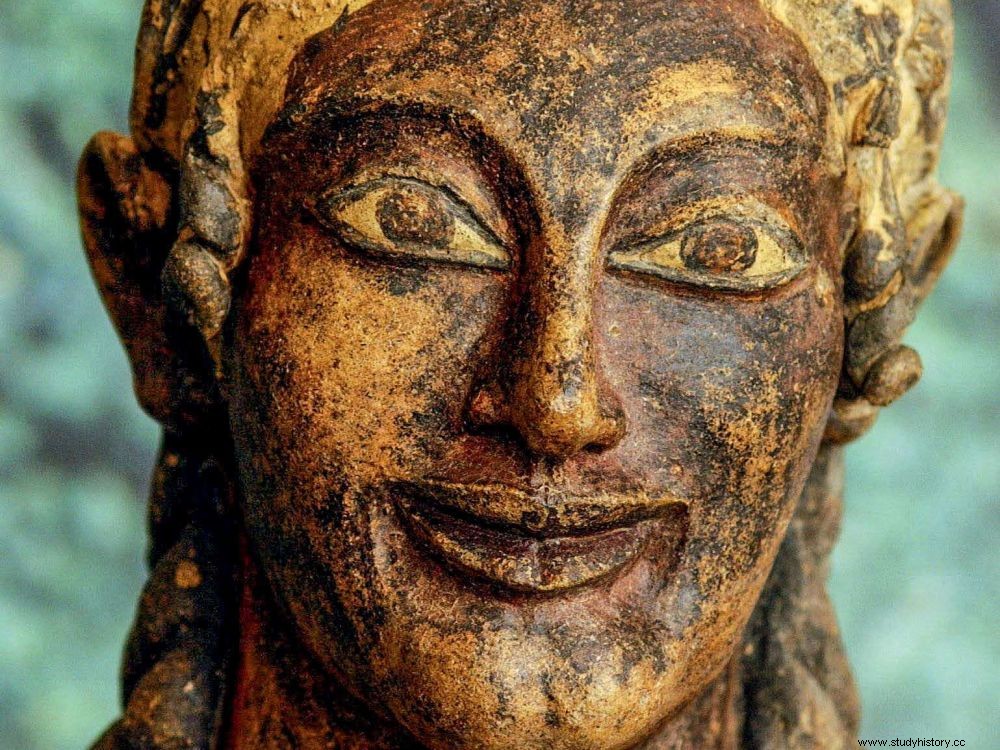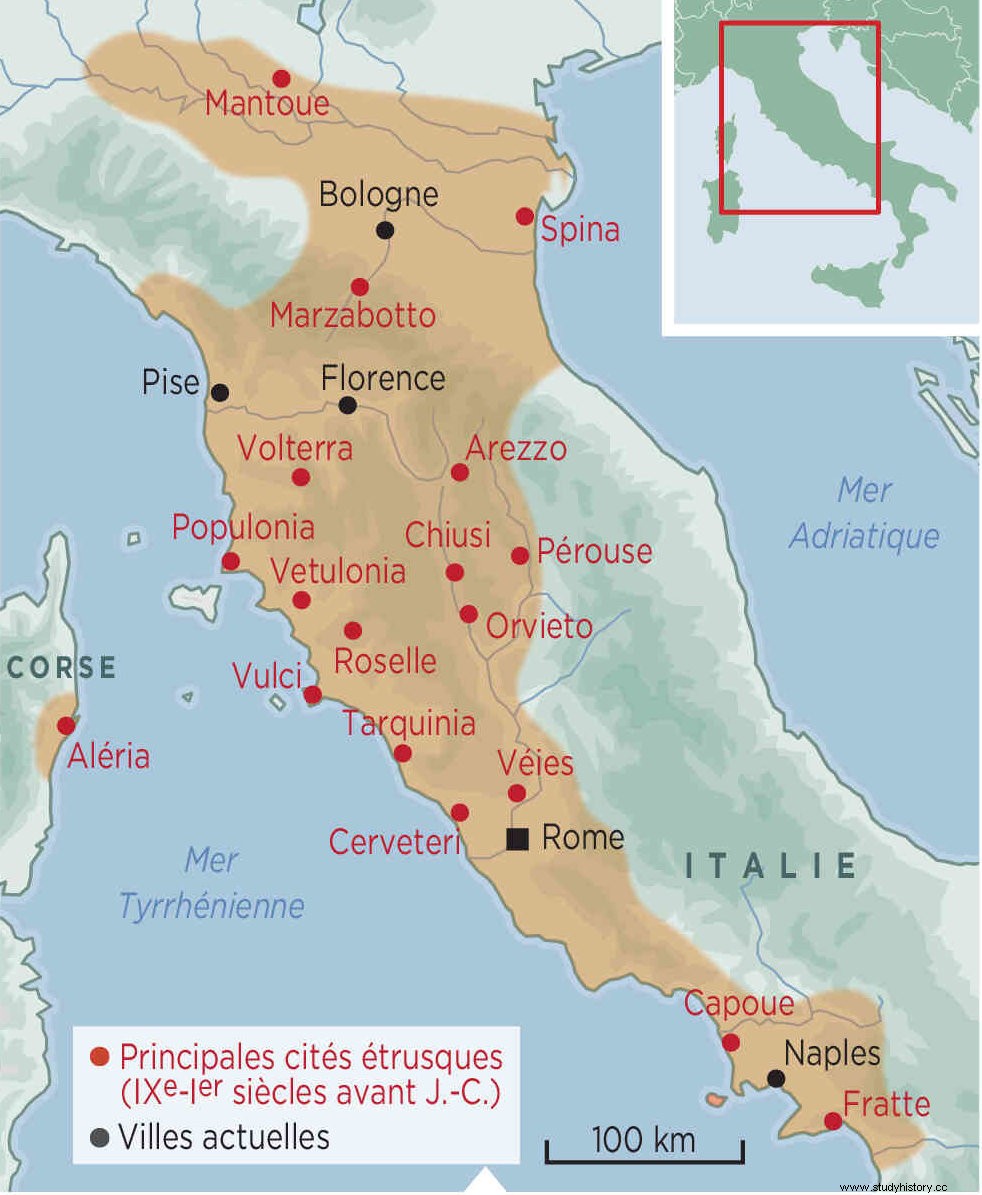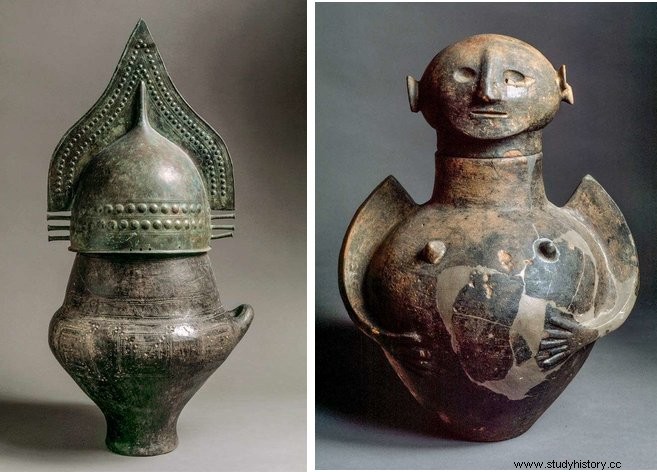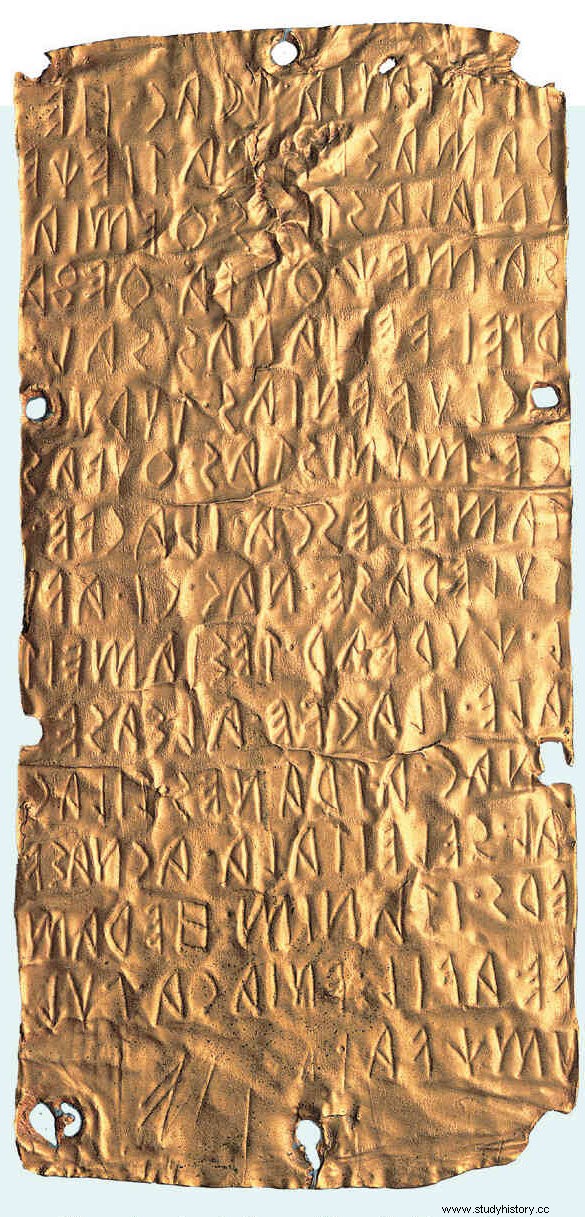Recent DNA analyzes confirm that this mysterious people who preceded the Romans did not originate from the Near East but from the Italian peninsula. And the latest archaeological discoveries refine the portrait of a brilliant civilization.

For several centuries, from the Iron Age to the Roman conquest, the Etruscans dominated part of present-day Italy. It was in one of the most powerful of their cities, Veii, that this monumental terracotta Apollo was erected (6th century BC).
This article is taken from the monthly magazine Sciences et Avenir - La Recherche n°904, dated June 2022.
It was the main civilization of the pre-Roman Mediterranean. Appeared in the Iron Age, in the 9th - 8th centuries BC, in this period that the Italians call Villanovan, those that the Greeks called Tyrrhenoi and the Romans Etrusci occupied much of Italy and its outskirts until the century BC, when their territory was conquered and absorbed into the Roman Republic.
However, they are sometimes considered the great forgotten of ancient history. Their very origin is an interminable subject of debate. From antiquity, some had attributed to this people an origin outside the peninsula. The Greek historian Hellanicos of Lesbos, in the 5th century BC, for example, saw in them Orientals. Herodotus - the " father of history" - estimated at the same time that they could be Lydian settlers from the south-west of present-day Turkey. Only the Greek Dionysius of Halicarnassus, in the 1st century BC. , considered that the Etruscans were a locally evolved population, and it is this so-called autochthonous hypothesis that seems to be confirmed by the most recent genetic analyses.
A homogeneous genetic group
In 2021, a genomic analysis covering 2000 years of Italian history, and concerning Tuscany, Basilicata and Lazio, was carried out on 82 individuals collected from 12 archaeological sites. It has established that in the Iron Age (from 900 BC), the Etruscan populations of central Italy were of autochthonous origin and formed a homogeneous genetic group. These results showed that the Etruscans indeed carried a genetic profile shared with other neighboring contemporary populations such as the Latins of Rome. Hence the conclusions of the geneticist Johannes Krause, director of the Max-Planck Institute for Evolutionary Anthropology, in Jena (Germany), at the origin of the study:"Contrary to certain hypotheses, the genetic pool Etruscan does not seem to come from movements of populations originating in the Near East. " Which is to say that the genetic heritage of the Etruscans remained stable for at least 800 years, from the Iron Age to the period of the Roman Republic. The Etruscans were therefore a population that simply evolved on the spot, coming from the Villanovians, people of the Bronze Age who preceded them.An explanation more and more consensual among specialists, if not unanimity.
This article is taken from the monthly magazine Sciences et Avenir - La Recherche n°904, dated June 2022.
It was the main civilization of the pre-Roman Mediterranean. Appeared in the Iron Age, in the 9th - 8th centuries BC, in this period that the Italians call Villanovan, those that the Greeks called Tyrrhenoi and the Romans Etrusci occupied much of Italy and its outskirts until the century BC, when their territory was conquered and absorbed into the Roman Republic.
However, they are sometimes considered the great forgotten of ancient history. Their very origin is an interminable subject of debate. From antiquity, some had attributed to this people an origin outside the peninsula. The Greek historian Hellanicos of Lesbos, in the 5th century BC, for example, saw in them Orientals. Herodotus - the " father of history" - estimated at the same time that they could be Lydian settlers from the south-west of present-day Turkey. Only the Greek Dionysius of Halicarnassus, in the 1st century BC. , considered that the Etruscans were a locally evolved population, and it is this so-called autochthonous hypothesis that seems to be confirmed by the most recent genetic analyses.
A homogeneous genetic group
In 2021, a genomic analysis covering 2000 years of Italian history, and concerning Tuscany, Basilicata and Lazio, was carried out on 82 individuals collected from 12 archaeological sites. It has established that in the Iron Age (from 900 BC), the Etruscan populations of central Italy were of autochthonous origin and formed a homogeneous genetic group. These results showed that the Etruscans indeed carried a genetic profile shared with other neighboring contemporary populations such as the Latins of Rome. Hence the conclusions of the geneticist Johannes Krause, director of the Max-Planck Institute for Evolutionary Anthropology, in Jena (Germany), at the origin of the study:"Contrary to certain hypotheses, the genetic pool Etruscan does not seem to come from movements of populations originating in the Near East. " Which is to say that the genetic heritage of the Etruscans remained stable for at least 800 years, from the Iron Age to the period of the Roman Republic. The Etruscans were therefore a population that simply evolved on the spot, coming from the Villanovians, people of the Bronze Age who preceded them.An explanation more and more consensual among specialists, if not unanimity.
However, what we know of the Etruscans comes essentially from archaeology, of which each new discovery refines the portrait of these early Italics. Thus, in March 2019, a rich Etruscan tomb 24 centuries old was exhumed near Aleria, on the east coast of Corsica. A hypogeum from the 4th century BC found intact on the Isle of Beauty, a first for forty years. Whether it's tombs, or wrecks loaded with cargo from what the Greeks called emporia , we guess the richness of the Etruscan counters. This civilization dominated for several centuries a vast area in Etruria, a region stretching from the Po plain in northern Italy to Campania in the south-west, but also in the eastern plain of Corsica in from the 6th century BC, and southern Gaul to the Iberian coasts.

Etruria constituted a vast space, from the plain of the Po to Campania, also biting into Corsica and the south of Gaul. Credits:BRUNO BOURGEOIS
The Etruscans were in fact distinguished very early on by their great openness to the outside world. From Tyrrhenian Etruria, these refined navigators and craftsmen had drawn closer to their neighbors through trade. It must be said that they were not lacking in resources. Starting with agricultural export products such as wine, but above all mineral wealth. If they produce iron and copper, they are also looking for tin. As many products as they exchanged from the 7th century BC with the Phoenician-Punic civilizations (Phoenicians and Carthaginians), Nuragic civilizations of Sardinia of the Iron Age, or those located at the end of the western Mediterranean and Spain, while trading with the Greek colonists of the Anatolian coast (now Turkey) and the Phocaeans who founded Massalia (Marseille), settled in southern Gaul.
However, very few Greek or Latin contemporaries mention them. In addition, no text of which the Etruscans would be the authors has unfortunately survived to shed direct light on their history. Indeed, if they have a writing, "the 11,000 inscriptions that have reached us do not allow us to learn much about them ", says Gilles van Heems, lecturer in Latin language and literature at the University Louis-Lumière
Lyon II, attached to the Hisoma laboratory, of the Maison de l'Orient et de la Méditerranée, in Lyon. Because contrary to popular belief, if this writing has been deciphered, it remains most often incomprehensible (read the box below). The Etruscans borrowed it from the Greek colonists of Euboea, who settled as early as 775 BC in Pithekusses (today the island of Ischia, opposite Naples). Through their contact, they also became acquainted with other intangible assets such as Greek mythology and great literary texts. Through the Euboeans, the Etruscans discovered above all the ritual ceremony of the banquet. The one represented by joyful and colorful scenes found in the frescoes of the tombs of the Etruscan elite, which the Romans, later, will associate with debauchery!
"The disciplined body of the Greeks and Romans was opposed by the more relaxed Etruscans “, explains Marie-Laurence Haack, professor of ancient history at the Picardie-Jules-Verne University, in Amiens (Somme), who has just devoted a book to them*. The Etruscans indeed liked to banquet with their wives. horrifies Romans and Greeks who only accept as female presence in their symposium that of servants and prostitutes. "Among the Romans, women had to stay at home, just as among the Greeks, while among the Etruscans, mothers, daughters, wives could attend banquets as men, continues Marie-Laurence Haack. They seem to have given women a status that was denied to them in other cultures of antiquity, and an undeniable joie de vivre seemed to reign among them. "
A language that we can read, but do not understand
Contrary to a myth, the Etruscan language is deciphered insofar as one can perfectly read its inscriptions. The Etruscans used an alphabet derived from Greek as early as the 8th century BC, which they adapted to their language to note its own sounds. The inscriptions, written from right to left or from left to right, have been read since the end of the 18th century. "But it is quite different with the meaning of what we read ", points out Gilles van Heems, from the Hisoma laboratory in Lyon. Etruscan does not belong to any identified linguistic family, it is impossible to use other languages to really understand these inscriptions.
With its 11,000 short texts (70% are funerary certificates or onomastic inscriptions) and rare long texts (including one figured on the strips of a mummy kept in Zagreb, Croatia, and another, legal, discovered in Perugia, in Italy), Etruscan is today classified as an isolated and dead language which no longer has any living descendants. Found in Italy, southern Gaul, Corsica, North Africa or Greece, this writing appeared around 700 BC, and the last recorded inscriptions date back to the 1st century. The Etruscans originated the alphabet later used by the Romans, and which is ours today.
One of the three bladelets of Pyrgi, Etruscan inscriptions on gold leaf from Cerveteri (6th century BC). Credits:BRIDGEMAN IMAGES
A sophisticated system for interpreting divine signs
Described as the most religious people of Antiquity, the Etruscans wanted to guess all the manifestations of the gods to permanently know their feelings towards men. What had led them to work out and develop a sophisticated system of interpretation of the divine signs. The omens that could be observed in the sky - with lightning, lightning or the flight of birds - were analyzed by augurs, while haruspices, other specialized priests, took charge of the entrails of animals whose color they examined. , place, size or shape. This science was mainly developed around the livers, lungs and intestines of sacrificed animals, like that practiced by the ancient Sumerians, in the 2nd millennium BC, for whom the liver was the organ where thought sat.
A rare example of this art of hepatoscopy or hepatomancy that has come down to us is the bronze liver from Plaisance, unearthed by a farmer in 1877 in Emilia-Romagna (Italy). We see how this organ materializing the sky was divided into quarters. Each portion being dedicated to a particular deity, it could be read. Etruscan divination would later inspire the Romans, who were very concerned about satisfying the "peace of the gods" and eager to know if they were going to be able to win victories. Full of blood, the liver was a symbol of life, reflecting a kind of terrestrial microcosm - a reduced image of the world and society - and celestial macrocosm - the Universe.
A certain conception of the afterlife among the Etruscans had also led them to build imposing necropolises, made up of monumental tombs decorated with frescoes. Like those of Tarquinia, or Banditaccia, near Cerveteri, in Lazio. Last prerogative of a treatment of the dead which had undergone changes and made the Etruscans pass from cremation to burials, and from tumuli monumental to simpler tombs.
In the oldest phases, called Villanovan, we find in southern Tuscany and northern Latium clay funerary urns in the shape of "huts". Characteristic of these same periods, cinerary vases were sealed with a cup if the deceased was a woman, or a helmet if it was a man. Or the canopic jars of Chiusi, in Tuscany, whose lids represent the heads of deceased persons. Later, funerary vats, carved in alabaster or travertine (volcanic tuff), will offer sophisticated sculptures of figures lying on a klinê (bed used in banquets), accompanied by scenes evoking the journey to the afterlife. Up to imposing clay sarcophagi decorated with sumptuous decorations, intended to accommodate burials.

Cinerary vases:on the left, the helmet which covers it indicates that the deceased was a man; on the right, the "canopus" vase of Chiusi reveals that it is a woman. Credits:AKG IMAGES - BRIDGEMAN IMAGES
People of the land as much as of the sea, the Etruscans have always been considered a singular people. Perhaps this is why Rome borrowed many customs from them, such as the wearing of the toga edged with purple or objects, such as the curule chair of the magistrates. Some Etruscan symbols even persist to the present day, like the lictor's fasces which became symbols of Roman power and authority, then were reinterpreted during the French Revolution before appearing today on the coat of arms of the presidency of the Italian Republic!
* "Discovering the Etruscans" , Marie-Laurence Haack, Discovery, 2021
A civilization "recovered" by fascism
"By looking at the historiography of Etruscology and its birth at the beginning of the century, we learn that the construction of this discipline, from an academic and scientific point of view, is linked to fascism" , explains historian Marie-Laurence Haack. Its founder, Mussolini, had encouraged the study of the Etruscans, this "super-race of the Italian nation" , as glorious ancestors. A bit like Napoleon III had done in France with the Gauls. "A subject that is still taboo in Italy. Working on Antiquity is also doing it on the modern world. It's not just erudition!" , recalls Marie-Laurent Haack.
TO FIND OUT MORE
"Etruscans, a civilization of the Mediterranean ", exhibition at the Museum of Romanity, in Nîmes, until October 23.

